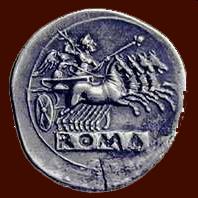









Looking After Your Finds - Finds




Roman - Identification Pendants - Jewellery


Powered By Sispro1

Copyright All Rights Reserved by Nigel G Wilcox E-Mail: ngwilcox100@gmail.com
Unearths rare find
Metal detecting on land owned by James Wildon in Handsacre.
TWO "bits of metal" found by a Tamworth man have officially been declared as treasure.
Belgrave resident Graham Hogg found two incomplete clothes fasteners on June 22, 2014. He had in fact unearthed two precious metal dress hooks dating back to between the 16th and 17th Centuries.
A treasure inquest in to the items was held at Cannock Coroner's Court on Tuesday (July 21), during which the court heard from Teresa Gilmore, the finds liaison officers for Staffordshire and the West Midlands, from the Birmingham Museums Trust and Portable Antiquities Scheme.
the front of both hooks were 39.5 percent and 34.6 percent gold, and 42.4 percent and 49 percent silver.back of the hooks were 86 and 82 percent silver respectively and definitely over 300 years old
Metal detecting on land owned by James Wildon in Handsacre.
TWO "bits of metal" found by a Tamworth man have officially been declared as treasure.
Belgrave resident Graham Hogg found two incomplete clothes fasteners on June 22, 2014. He had in fact unearthed two precious metal dress hooks dating back to between the 16th and 17th Centuries.
A treasure inquest in to the items was held at Cannock Coroner's Court on Tuesday (July 21), during which the court heard from Teresa Gilmore, the finds liaison officers for Staffordshire and the West Midlands, from the Birmingham Museums Trust and Portable Antiquities Scheme.
the front of both hooks were 39.5 percent and 34.6 percent gold, and 42.4 percent and 49 percent silver.back of the hooks were 86 and 82 percent silver respectively and definitely over 300 years old
dates to between AD 1200 to 1400
two stirrup rings
Designed by Nigel G Wilcox
Complimentary Topics
The Paragon Of Metal Detecting
& Archaeology
& Archaeology
1.
2.
3.
6.
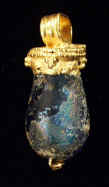
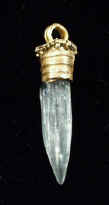
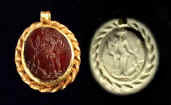
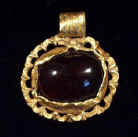
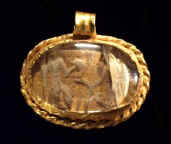
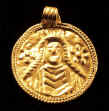
ROMAN GOLD AND GLASS PENDANT I c. A.D.
Suspension loop made of double grooved strip soldered to round horizontal plate with beaded wire border. Tubular vertical part decorated with four triangular clusters of granulation under beaded wire border. Blue-glass bead strung lengthwise with a strip-twisted wire ending in a small twist with gold bead.
28 x 11 mm.
Suspension loop made of double grooved strip soldered to round horizontal plate with beaded wire border. Tubular vertical part decorated with four triangular clusters of granulation under beaded wire border. Blue-glass bead strung lengthwise with a strip-twisted wire ending in a small twist with gold bead.
28 x 11 mm.
ROMAN GOLD PENDANT I c. A.D.
Suspension loop made of grooved strip soldered to round horizontal plate with granulation along perimeter. Tubular vertical part articulated by horizontal ribs suspending an aquamarine in its natural crystal form. 24 x 6 mm.
This type of gold piece is typically used as a termination in necklaces or bracelets. This particular combination illustrates possible alternative uses. See Ogden J. Ancient Jewellery, 1992, p.36 on use of natural crystal forms in antiquity.
Suspension loop made of grooved strip soldered to round horizontal plate with granulation along perimeter. Tubular vertical part articulated by horizontal ribs suspending an aquamarine in its natural crystal form. 24 x 6 mm.
This type of gold piece is typically used as a termination in necklaces or bracelets. This particular combination illustrates possible alternative uses. See Ogden J. Ancient Jewellery, 1992, p.36 on use of natural crystal forms in antiquity.
ROMAN CARNELIAN AND GOLD PENDANT II c. A.D.
Flat carnelian set in oval box-type shield with twisted wire boarder. Ribbed wide loop soldered to the back and folded over. Intaglio depicts standing figure of Fortuna. Wearing chiton, holding cornucopia in her left hand and ears of wheat in right hand. Ship’s rudder by her right leg.
13 x 16 mm.
Flat carnelian set in oval box-type shield with twisted wire boarder. Ribbed wide loop soldered to the back and folded over. Intaglio depicts standing figure of Fortuna. Wearing chiton, holding cornucopia in her left hand and ears of wheat in right hand. Ship’s rudder by her right leg.
13 x 16 mm.
ROMAN GOLD AND GARNET PENDANT III c. A.D.
Oval garnet cabochon set in bezel with open work periphery. Ribbed wide loop soldered to the back, folded over, with free end at the front. 19 x 21 mm.
For the same open work periphery see: Ruseva-Prokoska L. Roman jewelry. A Collection of National Archaeological Museum-Sofia, Sofia, 1991
Oval garnet cabochon set in bezel with open work periphery. Ribbed wide loop soldered to the back, folded over, with free end at the front. 19 x 21 mm.
For the same open work periphery see: Ruseva-Prokoska L. Roman jewelry. A Collection of National Archaeological Museum-Sofia, Sofia, 1991
5.
ROMAN ROCK CRYSTAL AND GOLD PENDANT II c. A.D.
Convex rock crystal set in oval box-type shield with twisted wire boarder. Ribbed wide loop soldered to the back and folded over. Intaglio unconventionally faces gold background. Depicts two figures : Minerva standing to front with spear in right hand, shield by her feet and helmet in left hand; Fortuna stands to right holding cornucopia in her left hand and rudder in her right. Lateral crack. 18 x 20 mm.
Convex rock crystal set in oval box-type shield with twisted wire boarder. Ribbed wide loop soldered to the back and folded over. Intaglio unconventionally faces gold background. Depicts two figures : Minerva standing to front with spear in right hand, shield by her feet and helmet in left hand; Fortuna stands to right holding cornucopia in her left hand and rudder in her right. Lateral crack. 18 x 20 mm.
SARMATIAN GOLD PENDANT II-I c. B.C.
Disc is framed by a border of two twisted wires, simulating a braid. Ribbed loop soldered to the back, folded over with free end at the front. The repousse bust represents Cybele. Her hair falls in long curls along the neck and shoulders. Face features are shown schematically. She is wearing a vertically ribbed polos with serrated top; chiton with parallel angular draperies, necklace above; himation over her shoulders. Two rosettes on the background. 32 mm.
For similar iconography see: Rudolph W. A golden legacy. Ancient jewellery from the B.Y. Berry collection at the Indiana University Art Museum, 1995
Disc is framed by a border of two twisted wires, simulating a braid. Ribbed loop soldered to the back, folded over with free end at the front. The repousse bust represents Cybele. Her hair falls in long curls along the neck and shoulders. Face features are shown schematically. She is wearing a vertically ribbed polos with serrated top; chiton with parallel angular draperies, necklace above; himation over her shoulders. Two rosettes on the background. 32 mm.
For similar iconography see: Rudolph W. A golden legacy. Ancient jewellery from the B.Y. Berry collection at the Indiana University Art Museum, 1995
4.
Pages
B=Bracelets
ER=Ear-Rings
P=Pendants
T=Template
ER=Ear-Rings
P=Pendants
T=Template
Rings
[1]
[2]
[3]
[4]
B ER P T
[5]
[6]
[8]
Main Coin Menu
Roman Coins
Menu
Menu
Member NCMD
Roman Menu























